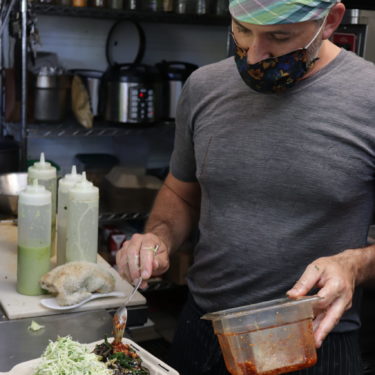I pulled up to Lou’s Takeaway on a warm Thursday afternoon to find a kitchen even smaller than what I had imagined during my interview with Chef Anthony Rizzi earlier in the week. A chalkboard menu hung in front of a takeaway window where a cheerful young man chatted with a woman, explaining the different components of menu items. I caught the phrases “Star Route Farms butter lettuce” and “freshly toasted spices,” antsy to see it in the flesh.
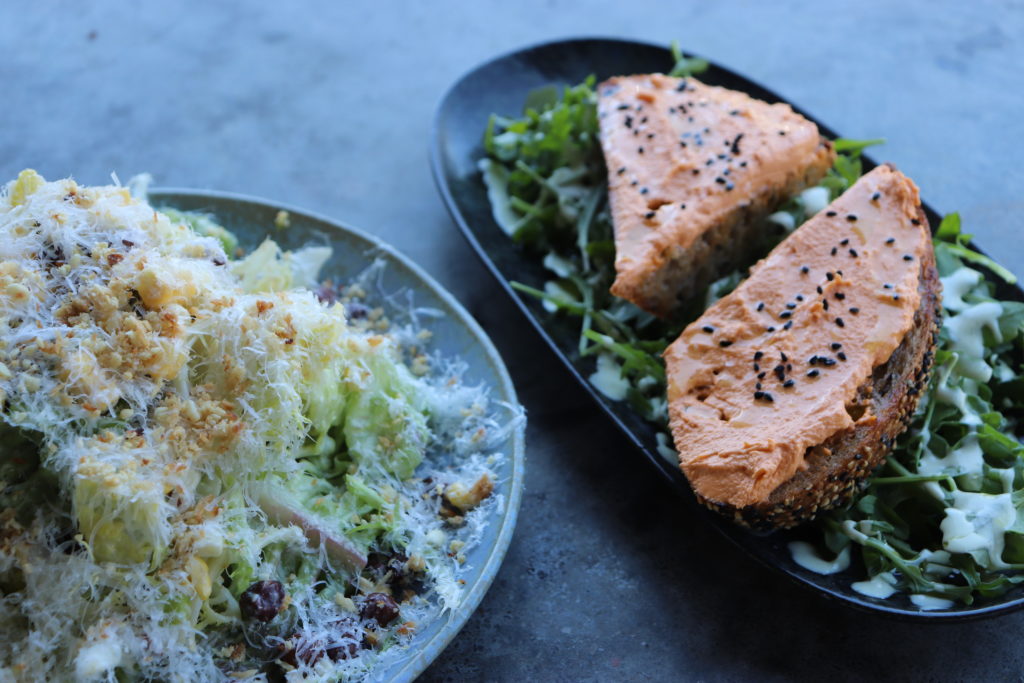
I had been eager to come see the restaurant since I had spoken to Anthony earlier in the week over the phone. Even then, I could feel his passion and dedication to what he does – cooking delicious comfort food with the best ingredients. It’s a simple operation they have running over at Lou’s Takeaway, just Anthony and 2 employees in this self proclaimed “pint sized eatery.” What goes into this food, however, is quite literally the antithesis of simple.
Everything, and I mean everything, produced from this kitchen is 100% cooked from scratch. With two induction burners, three rice cookers, and one oven, Anthony brings local, seasonal, and fresh ingredients to life, seasonal and local produce being integral to the operation at Lou’s Takeaway. “I’m very committed to that… you visit the farmers and you see that you can talk about how they’ve made it, or how they grew it and why it’s not growing now… Because it’s a living thing and there’s different seasons… and we have so much in California that we can get, why would you not feature all of this great produce?!” he said with a laugh over the phone.
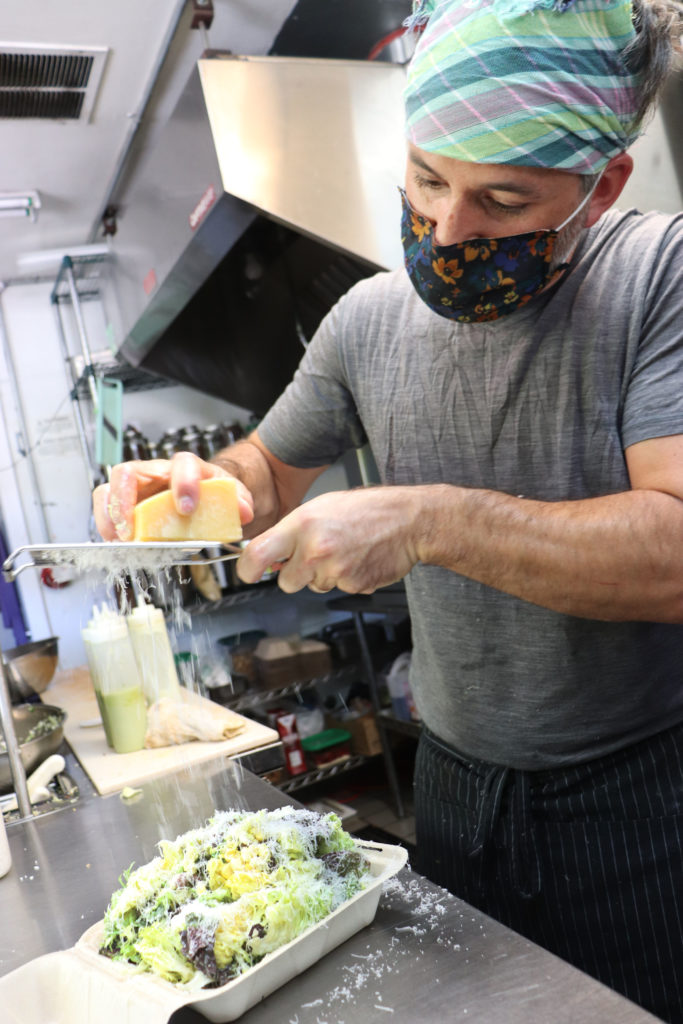
Anthony has lived the life that many of us, including myself, dream to live. He has travelled extensively, picking up culinary wisdom from each and every location along the way, all of these experiences ultimately coming together to inspire Lou’s Takeaway. “Really the inspiration of Lou’s Takeaway food is based off of [food] in most other countries, specifically Southeast Asia, China, Costa Rica, most other countries outside of the US and Canada, you have these little stalls and its not necessarily street food because a lot of that is one or two dishes, but they’ll have these rice stalls with 5 or 6 different pans with different braises or stews and then you just point to a couple things, put it over rice have a little side soup and that’s lunch…” he said. “It’s one person cooking it standing there serving it, they’re talking about each dish, you know, like what they recommend and how they made it, you know you can tell the pride that they take in it.”
Of all of the places he has travelled, Anthony spent the most significant chunk of time in Vietnam. He spent three years living there, from 2008-2010, and while he doesn’t consider his restaurant to be a Vietnamese restaurant, the dining culture and composition of Vietnamese meals and the way different ingredients are used in their cuisine continue to guide his cooking principles.
What he really loves though is to engage with food culture in different locations, always building on what he has already seen and experienced. “When you travel to different places you see the same ingredients at the markets I like to visit, like onion, tomato, garlic, potatoes, but every country, every region, prepares them in different ways so I’m always excited to see how even the most simple recipes, just a handful of ingredients are done in different ways,” he said.
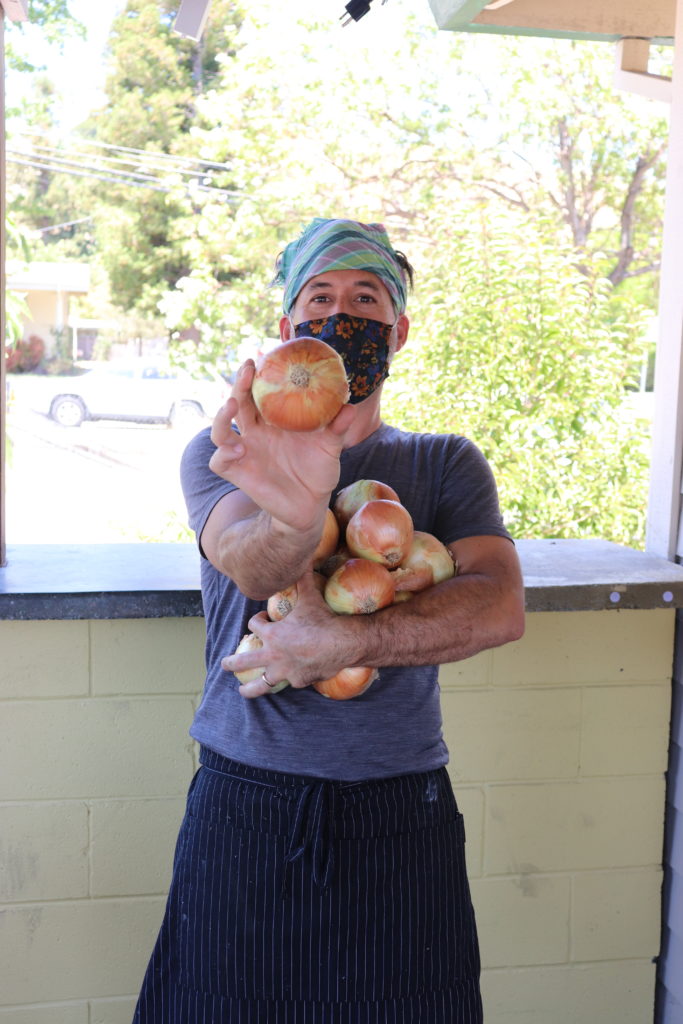
One of these preparations of a simple ingredient has stuck with Anthony in a significant way, the frying of the onion, which also happens to be Anthony’s favorite ingredient. He shared with me a charming story about how he discovered this technique, detailing how he was in India walking in this town that was famous for its Biryani, and telling me about these incredible onions that were always fried and put on top. “So I was walking down the street and I just smelled this intoxicating fragrance, fried onions… I look over and I see this guy and he’s got this massive carbon steel wok, you know, like filled with oil and he’s like tossing the onions just bubbling. And I was like ‘Oh my god, that’s why they smell so good,’ because he’s using a ton of oil and deep frying, as opposed to sauteing and sweating and steaming.” Anthony explained it to me in lay terms – the heat of the oil creates a mechanism to release more fragrance out of the onion. So that’s how they do it at Lou’s Takeaway, frying batch after batch of onions, to be used in braises and any other dish that Anthony dreams up. They collect the oil that the onion is fried in and use that as well, as Lou’s Takeaway prides itself upon using every possible part of an ingredient. Anthony referred to the “onion oil” as a “mother stock,” as they will use some of the onion oil in whatever dishes are being served up that day, and then fry the next batch of onions in the original oil leftover, forever concentrating the incredible flavor.
It’s these experiences travelling that really got him cooking and engaging in food culture in the first place – he doesn’t have classical training as a chef. He has worked shucking oysters at Hog Island, and has worked in a couple kitchens, but at the end of the day, in his words “I don’t really have much experience, I just like to eat and cook.”
It was, in fact, on a year of travelling with his wife in 2016, that the idea for Anthony to start his own restaurant was born. He credits this thought process to the large quantities of free time one has when travelling the world for a year, reminiscing about how him and his wife would daydream about what his own spot would look like – small, chalkboard menu, small menu… “just based on inspiration and what I felt like cooking.” His vision has basically become his reality, if I do say so myself.
And since his opening in August, Anthony’s following has grown immensely. When I asked if he thought about expanding to a larger spot, he was hesitant, and in his answer to the question, I began to truly understand the deep passion and care Anthony has for the dishes he produces from this kitchen. While he has two amazing employees, Anthony plates every single meal, and is so incredibly dedicated to each meal being consistently of the highest quality. He is worried about losing this quality if he was to expand, and in turn, losing some of “it’s special.”
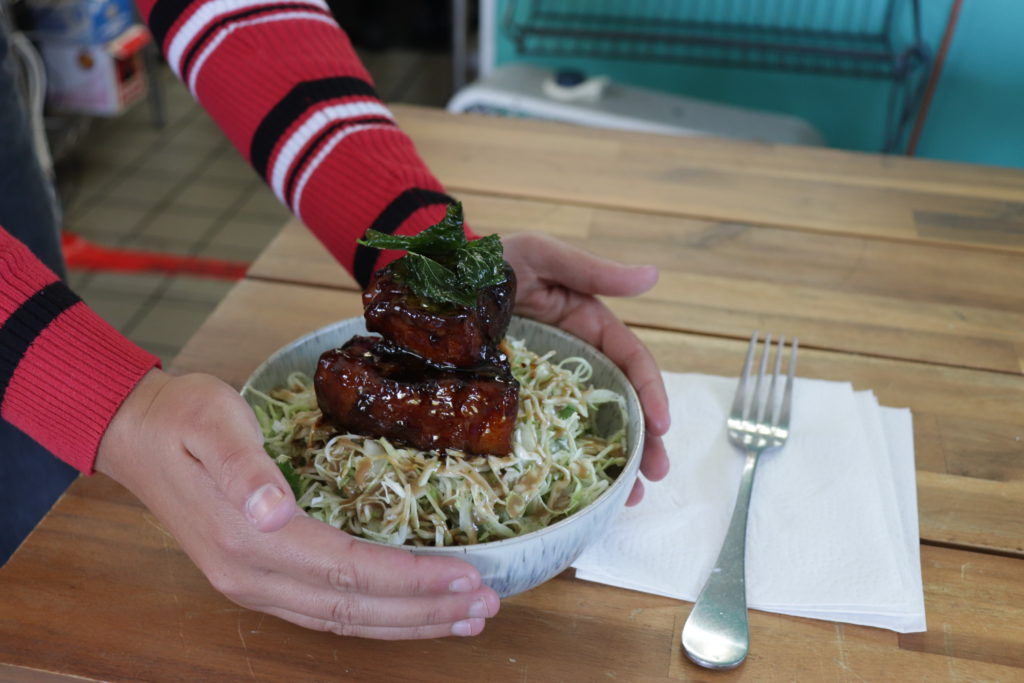
So I had heard all of these things from Anthony over the phone, not quite sure what to expect when actually meeting him and seeing the restaurant. The moment I walked into the kitchen, the image of Anthony that I had painted in my mind came alive. Working on dishing up meals as he chatted with us, Anthony sported a colorful headband and apron, his hands working seamlessly to pile dressed cabbage high atop glossy rice, topped with sticky, fragrant pork belly.
He is one of the people in the world that has so much intuitive sense of flavor, as he tossed salad and dished out toppings, it was easy to tell, this was what he was born to do.
We had the incredible pleasure of getting to taste some of his food too, and I can very much attest to his skill as a chef. As cheesy as it may sound, I could feel his passion in each bite of food, how much thought had gone into developing the flavor profiles, all of it beautiful and delicious.
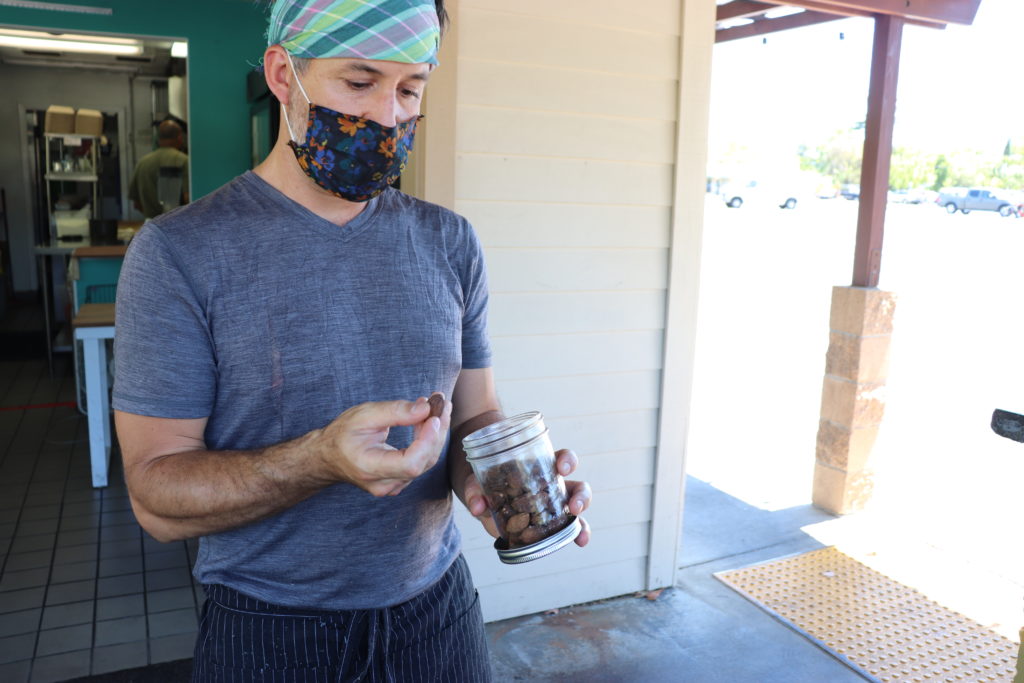
I think the most telling antidote of my experience at Lou’s Takeaway was when we were eating on a little counter outside and Anthony came outside with several jars of whole spices, and began explaining to us how important it is to always toast your own fresh spices, holding the jars out for us to smell, encouraging us to engage, smell the difference between cardamom and black cardamom. I could see the genuine light in his eyes as he chatted on, telling us about the different spice mixes he makes, the lengths he goes to to source some of them, pointing to the back of the kitchen where many other jars like the ones he held in front of us sat, waiting to have their flavor shared with the world by chef Anthony.
I encourage any of y’all reading to go see this incredible little restaurant for yourselves. You can find more information and a daily menu here.
And even more exciting… a recipe from Chef Anthony himself!
L.T. Braised Duroc Pork w/Turkish Apricots & Chilis
Ingredients:
3KG boneless pork shoulder butt (duroc breed preferred but anything fresh and nicely marbled you can find will do!)
3 large yellow onions, thinly sliced
5 cloves of garlic, smashed with the broad side of a knife
1/2 C crushed tomatoes or tomato puree
Chili Apricot Puree (see below)
1/4 C white vinegar, or to taste
2 T white sugar, or to taste
2 bay leaves, dried
Fresh mint, ~20 leaves, fried in 325F oil for 15 seconds (optional)
Toasted spice mix (see below)
Salt, to taste
Chili apricot puree:
6 puya chilis & 6-20 chili de arbol (depending on heat preference- you can use any combination of your favorite dried peppers here instead- guajillo, cascabel, new mexico are others I like)
8 turkish apricots, dried
2 C chicken stock (homemade preferred)
Toast chilis in a pan until fragrant (~30 seconds) and transfer to small pot with the turkish apricots and 2 C of stock. The seeds in some chilis can be bitter so I usually discard most of them. Your choice. Simmer covered for about 10 minutes until the chilis have softened. Transfer this mixture to a blender and puree until smooth.
TIP: Add your solids (chilis & apricots) into the blender first with just a little bit of the stock. Turn on the blender (cover the blender opening at the top with a towel so the steam can release without blowing the lid off) and slowly add your broth. It will be quite thick and probably won’t ‘tornado’ in the beginning but this is what you want. Starting with a thick mixture creates more surface contact with the blender blades and thus a finer chili puree without noticeable bits of pepper skin. Keep adding stock until the mixture smooths out. If you need to add more liquid to achieve this consistency add a bit of water.
Toasted Spice mix:
1/4 C indian coriander seeds
1 T black peppercorns, 1 T cumin seeds, 1 T sichuan peppercorns
1 piece star anise, 4 cloves, 6 green cardamom (inner dark seeds only, discard green shell)
Heat pan on medium heat, add all the spices and toast for about 1 minute, stirring frequently until they become fragrant. Be careful not to burn! Let cool and grind in blender or molcajete.
Directions:
Starting the night before, dice pork shoulder in 1 1/4” cubes and salt. Start with ~4g kosher salt per pound of meat and you then you can always add more to taste as you’re finishing the sauce. Hand massage your pork to make sure each piece is evenly seasoned. Nothing worse than sloppily seasoned swine!
The next day, brown your pork shoulder in batches on a pan with vegetable oil. When they’re all sufficiently browned to your liking (don’t go too crazy here, you will be browning the pork again at the end) add your sliced onion to the pan, along with more oil and sauté on medium heat, stirring often until light golden brown and quite wilted. You want enough oil for your onions to be sliding and ‘dancing’ as your cook them. Don’t worry, you won’t consume all this oil- but it’s essential to help the onions brown evenly and bring out their lovely aromatics. Onions are life! If you have onions and chicken stock you can make almost anything delicious. Always remember this. At this point add in the smashed garlic cloves and cook for a couple minute until the raw smell dissipates, then add your crushed tomatoes. It won’t seem like that much tomato but think of it more as an onion sauce with some tomato for body and acidity. Cover the pan and cook tomatoes on medium low heat, checking every few minutes to make sure they don’t scorch on the bottom of the pan. After about 10 minutes add your chili apricot puree, chicken stock, sugar, vinegar & bay leaves. Bring this mixture to a simmer, pour it over the browned pork in a dutch oven or any baking dish you have. Cover and place in your oven for as low as you have time for. At 225 the pork should take about 2 1/2 – 3 hours. At 200 it could be closer to 4 hours or longer. ‘Doneness’ is also a personal preference but for me I think the shoulder braise is the most pleasurable when tender enough to break apart with a spoon but still firm enough to hold it’s shape. This way you experience tender meat and soft fat while still having something to bite into. After the 3 hours or so, there will be a good amount of red oil on the surface of your pork braise. Only leave as much as you’re comfortable with and spoon the rest off. Reserve for garnishing this dish (provides a nice color contrast if you want to top the braise with feta or another white cheese) or flavoring other dishes (scrambled eggs, brushed on grilled meats- will keep for about a week in fridge). Now taste the sauce, should be a little tart with a nice punch of slowly developing heat. Don’t worry if it tastes a bit under-seasoned – you will be reducing the sauce and thus concentrating the flavors. Take your pan from the oven and place it on a burner to cook the sauce down. If you’re worried about the pork being too tender and falling apart- take the pieces out of the pan while you reduce the sauce. Continue to taste as the sauce bubbles and reduces. Note how the bubbles become thicker and the collagen in the stock concentrates.This means you’re getting close! Stir frequently as it thickens so it doesn’t scorch. Once it’s just about as reduced as you’d like but still a bit loose add pork back into the pan and place it in your oven underneath the broiler. This is a critical step in creating as much flavor as possible. The sugar in the apricots, onions and tomatoes will caramelize under the intense direct heat and will take the dish to the next level. Keep an eye on it as this will happen pretty quickly. If you like you can take the pan out and spoon the sauce over the pork pieces to caramelize. Once the braise has turned a nice color with charred spots on it, pull from oven and give your final flavor adjustments. More tart? Add a splash of vinegar. More seasoning? A sprinkle more of kosher. More sweet? You get the idea. This is your creation- make it yours! Finally, hit it with a liberal dusting of your fresh toasted spice mix and top with fried mint leaves. Serve with steamed rice and fresh lettuce greens. Enjoy!
Dahlia Zail is interning at the Conscious Kitchen for her second summer. She is a 3rd year student at Pitzer College studying Environmental Analysis with an emphasis in policy and agriculture.
Photos by Zoe Cowan
